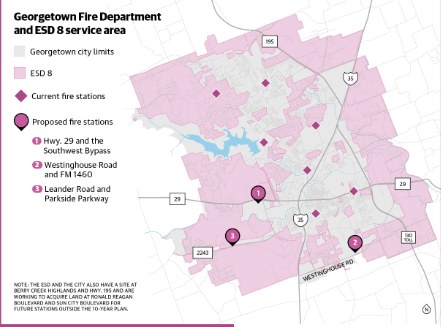ESD 8 and the Georgetown Fire Department partner to provide fire and emergency medical services to the city of Georgetown and the ETJ.
The ESD asked voters to approve the same measure last year, but the proposition failed.
Now, Georgetown Fire Chief John Sullivan is prioritizing education ahead of this year’s election.
“The need hasn’t changed since last year. In fact, I would argue, respectfully, that there’s even a stronger case for a sales and use tax,” Sullivan said.
What you need to know
ESD 8 and the city of Georgetown have a cost-sharing agreement to finance fire and EMS services. The agreement uses a formula that takes into account the population, the square footage of buildings and the number of calls for service in both the ETJ and the city, among other factors, to determine that the ESD should pay for about 20% of the total costs for services.
Sullivan said by structuring the department this way, neither entity is subsidizing the other, and neither is paying for the full cost of infrastructure and other shared resources.
The population of the ESD’s jurisdiction continues to grow, approaching nearly 40,000, Sullivan said. Reflecting on the last 10 years, Sullivan said calls for service increased by 250%, and if the department had not built new stations during that time, there would have been horrible outcomes for the community in terms of loss of life and property.
“This next 10 years is also critically important because the growth is continuing,” he said.
To address this growth, a master plan commissioned by the department recommends hiring six additional firefighters every year for the next 10 years and opening a new station every three years during that time.

However, Sullivan said the ESD is struggling to meet the financial obligations of the cost-sharing agreement, and would be unable to do so if the department moves forward with the master plan’s recommendations.
Furthermore, Sullivan said response times are getting longer in the ESD due to places being spread out and farther away from a station. Sullivan said it’s not uncommon for it to take 13-15 minutes for an ambulance to arrive on scene, despite the department’s goal of 10 minutes. The way to address this, he said, is more resources.
“The city of Georgetown and ESD 8 have had a longstanding partnership,” Georgetown City Manager David Morgan said in a statement. “Without the sales tax revenue, ESD 8 won’t be able to meet its obligations in the contract. As ESD 8 grows, this will limit the ability to hire firefighters and add new stations to maintain service levels.”
Explained
During the ESD’s education efforts, Sullivan said the department found people have misconceptions about what the increased sales tax would mean.
He said many people believed the rate in the ESD was already 8.25% and that approval of the proposition would raise the rate to 10.25%.
This is untrue, as the sales tax rate in the ESD is 6.25%—with all of the revenue going to the state. The election would raise the rate to 8.25%, with the extra 2% remaining with the ESD. Sullivan said many retailers, including online sellers, are already charging residents of the ESD 8.25%, and all of those dollars are going to the state.
“In this type of initiative, what we’re doing is we’re trying to provide more local control for how those dollars are spent,” Sullivan said.
Justin Word, one of the five commissioners for ESD 8, said another misconception is the thought that with all the new home growth, the ESD’s property tax rate of $0.096817 per $100 valuation would be able to sufficiently fund its operations.
He said a higher property tax rate would bring in the money to cover rising costs, but the state limits ESD property tax rates to $0.10 per $100 valuation.
Additionally, Sullivan said adding a sales tax to the ESD’s revenue streams distributes the tax burden to more than just residents of the ESD, with visitors to the area now helping to pay for services.

Looking ahead
If approved, Sullivan said the sales tax would provide the ESD $4 million more in revenue annually. If it’s not approved, Word said the district has no way to execute on the 10-year plan, meaning fire stations don’t get built and response times risk getting longer.
Neither ESD officials nor other involved parties had heard about any coordinated efforts against the proposition.
ESD resident Tom Grinstead went to an ESD event where he first heard about the ballot measure. He said he’s not worried about the sales tax increase, especially after learning he’s often already paying an 8.25% sales tax.
He said he wasn’t aware of the ballot measure last year, and doesn’t know if he saw it or how he voted. He fears the same thing will happen to others.
“I hope we’ve ... gotten the message out there so they understand what they’re voting for,” Word said.





